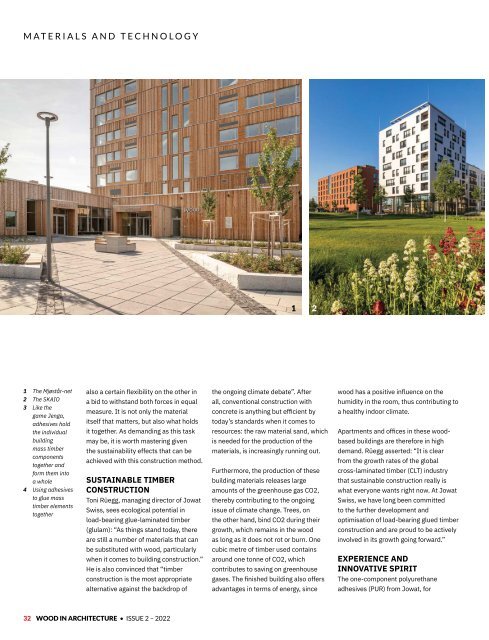Wood In Architecture Issue 2, 2022
First published in 2017, Wood in Architecture (WIA) is a bi-annual trade magazine devoted to the international timber construction sector. The newest addition to the Panels & Furniture Group of wood magazines, WIA features in-depth insights to the latest industry news, incredible projects and leading trade events. WIA is an advocate for timber as a material of choice for today’s built environment, and is the perfect source of inspiration for architects, builders, engineers and interior designers across the globe.
First published in 2017, Wood in Architecture (WIA) is a bi-annual trade magazine devoted to the international timber construction sector. The newest addition to the Panels & Furniture Group of wood magazines, WIA features in-depth insights to the latest industry news, incredible projects and leading trade events. WIA is an advocate for timber as a material of choice for today’s built environment, and is the perfect source of inspiration for architects, builders, engineers and interior designers across the globe.
Create successful ePaper yourself
Turn your PDF publications into a flip-book with our unique Google optimized e-Paper software.
MATERIALS AND TECHNOLOGY<br />
1 2<br />
1 The Mjøstår-net<br />
2 The SKAIO<br />
3 Like the<br />
game Jenga,<br />
adhesives hold<br />
the individual<br />
building<br />
mass timber<br />
components<br />
together and<br />
form them into<br />
a whole<br />
4 Using adhesives<br />
to glue mass<br />
timber elements<br />
together<br />
also a certain flexibility on the other in<br />
a bid to withstand both forces in equal<br />
measure. It is not only the material<br />
itself that matters, but also what holds<br />
it together. As demanding as this task<br />
may be, it is worth mastering given<br />
the sustainability effects that can be<br />
achieved with this construction method.<br />
SUSTAINABLE TIMBER<br />
CONSTRUCTION<br />
Toni Rüegg, managing director of Jowat<br />
Swiss, sees ecological potential in<br />
load-bearing glue-laminated timber<br />
(glulam): “As things stand today, there<br />
are still a number of materials that can<br />
be substituted with wood, particularly<br />
when it comes to building construction.”<br />
He is also convinced that “timber<br />
construction is the most appropriate<br />
alternative against the backdrop of<br />
the ongoing climate debate”. After<br />
all, conventional construction with<br />
concrete is anything but efficient by<br />
today’s standards when it comes to<br />
resources: the raw material sand, which<br />
is needed for the production of the<br />
materials, is increasingly running out.<br />
Furthermore, the production of these<br />
building materials releases large<br />
amounts of the greenhouse gas CO2,<br />
thereby contributing to the ongoing<br />
issue of climate change. Trees, on<br />
the other hand, bind CO2 during their<br />
growth, which remains in the wood<br />
as long as it does not rot or burn. One<br />
cubic metre of timber used contains<br />
around one tonne of CO2, which<br />
contributes to saving on greenhouse<br />
gases. The finished building also offers<br />
advantages in terms of energy, since<br />
wood has a positive influence on the<br />
humidity in the room, thus contributing to<br />
a healthy indoor climate.<br />
Apartments and offices in these woodbased<br />
buildings are therefore in high<br />
demand. Rüegg asserted: “It is clear<br />
from the growth rates of the global<br />
cross-laminated timber (CLT) industry<br />
that sustainable construction really is<br />
what everyone wants right now. At Jowat<br />
Swiss, we have long been committed<br />
to the further development and<br />
optimisation of load-bearing glued timber<br />
construction and are proud to be actively<br />
involved in its growth going forward.”<br />
EXPERIENCE AND<br />
INNOVATIVE SPIRIT<br />
The one-component polyurethane<br />
adhesives (PUR) from Jowat, for<br />
32 WOOD IN ARCHITECTURE • ISSUE 2 – <strong>2022</strong>


















